Effects of toxic metals on learning ability and behavior
3 min read
The human brain forms and develops over a long period of time compared to other organs, with neuron proliferation and migration continuing in the postnatal period. The blood-brain barrier is not fully developed until the middle of the first year of life. Similarly there is postnatal activity in the development of neuronal receptors and transmitter systems, as well as in the production of myelin. The fetus has been found to get significant exposure to toxic substances through maternal blood and across the placenta, with fetal levels of toxic metals often being higher than that of maternal blood (19,30-32,41,42,169b). Likewise infants have been found to get significant exposure to toxics, such as mercury and organochlorine compounds that their mother is exposed to, through breast-feeding (26,30-32,101,107,169b). Other toxic exposures are also extremely common as documented in Section IV.
The incidence of neurotoxic or immune reactive conditions such as autism, schizophrenia, ADD, dyslexia, learning disabilities, etc. have been increasing rapidly in recent years (2,80-82,113-115,143,144,149,169). A recent report by the National Research Council found that 50% of all pregnancies in the U.S. are now resulting in prenatal or postnatal mortality, significant birth defects, developmental neurological problems, or otherwise chronically unhealthy babies (82). There has been a similar sharp increase in developmental conditions in Canadian children (132), including increases in learning disabilities and behavioral problems, asthma and allergies, and childhood cancer. Not all children are equally affected by a given level of toxic exposures, and susceptibility factors such as immune reactivity, genetic factors affecting ability to excrete toxic metals, and other toxic exposures have major influences on toxicity effects.
A 2009 study found that inorganic mercury levels in people have been increasing rapidly in recent years (177). It used data from the U.S. Centers for Disease Control and Prevention’s National Health Nutrition Examination Survey(NHANES) finding that while inorganic mercury was detected in the blood of 2 percent of women aged 18 to 49 in the 1999-2000 NHANES survey, that level rose to 30 percent of women by 2005-2006. Surveys in all states using hair tests have found dangerous levels of mercury in an average of 22 % of the population, with over 30% in some states like Florida and New York (178).
Studies and clinical experience at treatment clinics have found consistently that gastrointestinal, immunologic and metabolic problems are found in children with ADHD, that are related to prenatal and neonatal exposure to toxic substances with much of these being related to vaccinations.(173) Lower GI dysfunction, enzyme deficiencies and impairments of hepatic detoxification pathways are very common. Many ADHD/autism patients have “leaky gut” syndrome, and inability to digest wheat gluten and milk casein, resulting in neurotoxic substances being dumped in the blood with significant adverse behavioral impacts.
Exposure to toxic chemicals or environmental factors appear to be a factor in at least 28 percent of the 4 million U.S. children born each year (6-23), with at least 1 in 6 having one of the neurological conditions previously listed according to the U.S. Census Bureau (82c). U.S. EPA estimates that over 3 million of these are related to lead or mercury toxicity, with approximately 25% of U.S. kids getting mercury exposure at dangerous levels (2,41,81,108). Evidence indicates that over 60,000 children are born each year with neurodevelopmental impairment due to methyl mercury (107,2), with even higher levels of exposure and impairment from two other sources, vaccines and mother’s amalgam dental fillings (81,169ab).






